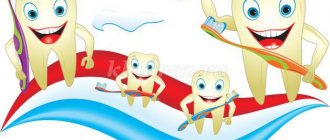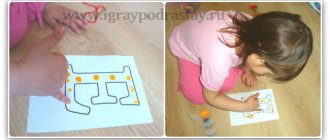Card file: “Conversations with children about a healthy lifestyle” (Senior group) TOPIC: “Child and health”
Municipal preschool educational institution Suslongersky kindergarten “Forest Fairy Tale”
Card file: “Conversations with children about a healthy lifestyle”
(Senior group)
TOPIC: “Child and health”
Prepared by: teacher 1st quarter. categories Idrisova T.V.
2018
Card file: “Conversations with children about a healthy lifestyle”
(Senior group)
TOPIC: “Child and health”
P.s.: to develop children’s initial skills in protecting life and health. Based on situational moments, learn to draw conclusions about life safety. Foster a sense of mutual assistance and a desire to help each other.
Progress of the lesson:
1) Talk about health, find out how children understand the word “health”:
health is the best wealth;
healthy - everything is great.
2) Bring in a casually dressed boy doll. Please note that dressing this way can harm your health.
3) Analyze situations when you need to behave carefully and take care of your health (how to walk on a wet floor so as not to slip; how to go down the stairs; how to dress when going for a walk).
Reading poems - advice.
OCTOBER
TOPIC: “Vegetables and fruits are healthy products”
P.S.: clarify children’s knowledge about healthy foods, their purpose for health and good mood. Fix the names of vegetables and their taste. Cultivate a desire to eat fruits.
Progress of the lesson:
1) Invite the children to remember what time of year it is now, show the gifts of autumn - a basket of fruits (examine and describe them).
2) Tell children about the health benefits of fruits for children and adults.
3) Ask what fruits parents buy for their children, remind them that in order to be strong and healthy, they must eat fresh fruits.
D/i “Guess the taste”, “Wonderful bag”.
NOVEMBER
TOPIC: “Personal hygiene”
P.s.: develop in children an understanding of the importance and necessity of hygiene procedures. Find out what accessories children use when washing. Learn to read clearly and emotionally.
Progress of the lesson:
1) Reading an excerpt from Mayakovsky’s poem “What is good and what is bad.”
2) Questions:
Which boy do you like better?
Why did you like the neat, neat boy?
Did anyone like the other boy?
Why didn't you like it?
What toiletries do you need to wash away dirt and be clean?
What, besides soap and a sponge, is needed for washing?
Invite children to show how children wash their hands and face (imitation movements)
3) Offer to learn a pure phrase:
Milu's mom
With soap soap...
DECEMBER
TOPIC: “Human Body”
P.s.: Clarify children’s knowledge of what parts the human body consists of, talk about the role of the senses. Learn to understand the meaning of certain parts of the body: arms, legs, head, torso. It is clear to answer the teacher’s questions. Cultivate the desire to grow up strong and healthy.
Conversation on the topic “Health is life. Take care of him"
Goals:
Draw children's attention to the problem of their health;
Discuss risk factors for the health of modern children, introduce basic recommendations for maintaining child health and instilling healthy lifestyle rules.
Progress of the conversation
1. Organizational moment. Statement of the problem and goals of the conversation.
2. The main part of the conversation.
To begin with, I want to tell you a parable.
A man lived in one house. His wife, his elderly sick mother and his daughter, an adult girl, lived with him. One late evening, when everyone was already asleep, someone knocked on the door. The owner stood up and opened the door. Three people stood on the threshold of the house. "What is your name?" - asked the owner. They answered him: “Our names are Health, Wealth and Love, Let us into your home.” The man thought, “You know,” he said, “we have only one free place in the house, and there are three of you.” I’ll go and consult with the household about which of you we can accept in our house.” The sick mother offered to let Health in, the young daughter wanted to let Love in, and the wife insisted that Wealth come into the house. The women argued among themselves for a very long time. When the man opened the door, there was no one outside the threshold.
I really want something like this to not happen in your home. And Health, and therefore Love and Wealth, will find shelter in your home. (I think everyone agrees that these components of human happiness need to be placed in that order.) What do you need to know about a teenager and his health? What should you pay attention to? We will now try to answer these questions.
Adolescence is the most difficult and most important period in a person’s life. Let me remind you of the main signs of this age.
– Adolescence is characterized by intense growth. Except for the first two years of life, a person never grows that fast again. Body length increases by 5-8 cm per year. Girls grow most actively at 11-12 years of age (height during this period can increase by 10 cm per year), increased growth of boys is observed at 13-14 years of age. (After 15 years, boys outstrip girls in height). The characteristic of a “long-legged teenager” is very accurate: the increase in height is mainly due to the tubular bones of the limbs.
– The musculoskeletal system is reconstructed: the degree of ossification increases, muscle strength increases. The sensory and motor endings of the neuromuscular system reach full development. These changes are manifested even externally: there is an abundance of unnecessary movements, awkwardness, and “angularity” of the teenager. You should know that at this age, mastering the technique of complex movements can be the most successful. A teenager can achieve virtuoso technique in playing a musical instrument and master the most complex elements of special sports exercises. Some researchers believe that people who do not develop the necessary motor skills during adolescence remain more awkward throughout their lives than they otherwise would have been.
– The teenager’s chest and respiratory muscles develop intensively. The number of respirations decreases by half, that is, the teenager breathes less often, but deeper. The body requires oxygen. It has been noted that a teenager suffers from its lack (hypoxia) much more severely than an adult.
– The heart is growing rapidly. Its volume increases by about a quarter. The blood vessels grow, but do not keep pace with the heart. Therefore, adolescents often have high blood pressure, and juvenile hypertension is sometimes observed. It is transient in nature, but requires special care when dosing physical activity. Not only physical activity, but also negative emotions are reflected unfavorably.
– The state of the nervous system changes. As a result, the behavior of adolescents is characterized by increased nervousness, lack of restraint, and instability of emotional reactions.
What problems related to adolescent health are the most pressing? What do you need to know and what to pay attention to?
1. The problem of healthy eating.
Interesting Facts
:
– Compared to 1960, children have become more relaxed in their choice of products. If previously only 24% of children demanded freedom of food choice, now 90% insist on this right;
– 66% of children want to eat differently. Depending on your gender;
– boys have a three times larger food budget than girls;
– boys consume on average 55.5% more calories than girls;
– 20% of boys are overweight compared to the norm. This is observed all over the world.
During the months of rapid growth, they often feel causeless muscle weakness. Sometimes they get tired very quickly after sports activities and complain of pain in the heart area. Cardiologists believe that this is due to a lack of carnitine, a substance that ensures the delivery of “fuel” to the energy systems of cells. In adolescents, carnitine production lags behind the needs of rapidly growing tissues. There is increased fatigue and low performance. And carnitine is found in beef and veal meat. There is a lot of it in milk. If a teenager eats enough meat, he may not notice the growth of his heart - he will be moderately cheerful and energetic.
2. Teenagers' passion for diets.
According to research, 73% of girls say they have been on a diet in the past 12 months. However, most of these girls are not overweight. Meanwhile, parents need to be aware that diets are dangerous for teenagers. Particular attention should be paid to this by parents whose daughters, from the age of 15, begin to torture themselves with various diets, trying to look like real fashion models. Scientists from the University of Missouri discovered interesting facts. They concluded that those children who eat less often with their parents and watch TV more often become overweight.
3. Physical inactivity is a problem of modern teenagers.
Lack of physical activity and excessive calorie intake have meant that the average modern child weighs significantly more than several generations ago. If the heart is not loaded, it will not become resilient. The heart muscle, like any other, requires training. Nature created this organ for a person who spends all day in motion. American experts have concluded that if one devotes at least 15 minutes a day to outdoor games, this reduces the risk of developing obesity by 50%. Even a brisk walk gives a positive result.
4. Stress and its impact on a teenager.
Stress is a universal phenomenon in the lives of modern teenagers, affecting their health and well-being. Parents of teenagers should be aware of the possibility of stress and behave correctly in these conditions. It may be sometimes advisable to lower the bar of demands placed on the child.
Many parents put a lot of direct and indirect pressure on their teenagers, both in terms of physical development and academic performance. In some cases, teen stress symptoms may be a reaction to parental pressure. A teenage athlete who has been competing since an early age may become tired of competition, but may not be able to express this to his parents. He may experience fear that his parents will be disappointed.
Peer support is important during this period. Adolescents who feel socially isolated or have difficulties relating to peers appear to be more vulnerable to stress-related psychosomatic problems.
Family support may also modify the impact of stress on adolescent health. Only it must be properly organized. It is wrong to respond to a teenager’s problems by attracting special attention and providing some privileges.
When parents behave this way, children will use their painful symptoms as a way to avoid a problematic situation (for example, exams or competitions).
Bad habits
.
Alarming facts:
-Currently, the average age for starting consumption of alcoholic beverages in Russia is 12-13 years. In the age group of 11-24 years, more than 70% of young people consume alcohol. At the same time, girls consume almost on a par with boys.
– On average in Russia, 35.6% of boys under 15 and 25% of girls smoke. And at the age of 16-17 years, this ratio looks like 45% to 18%.
– More than a quarter of girls and more than half of boys have tried drugs at least once by the age of 16.
Talking to teenagers about the dangers of smoking is very difficult. They don't believe. But it is necessary to tell what happens to a person when he smokes, and how this habit threatens him in the future. Therefore, I want to introduce you to some arguments.
At the moment of inhaling, tobacco and tissue paper sublimate, and about 200 harmful substances are formed, including carbon monoxide, soot, benzopyrene, formic and hydrocyanic acids, arsenic, ammonia, hydrogen sulfide, acetylene, and radioactive elements.
Smoking one cigarette is equivalent to being on a busy motorway for 36 hours.
Carbon monoxide (carbon monoxide) has the property of binding the respiratory pigment of the blood - hemoglobin, as a result of which tissue respiration processes are disrupted. When smoking a pack of cigarettes, a person introduces over 400 milliliters of carbon monoxide into the body, as a result, all organs and systems of the smoker are constantly starved of oxygen.
Passing through the respiratory tract, tobacco smoke causes irritation and inflammation of the mucous membranes - pharynx, nasopharynx, bronchi, and pulmonary alveoli. Constant irritation of the bronchial mucosa can trigger the development of bronchial asthma. And chronic inflammation of the upper respiratory tract is chronic bronchitis, which is accompanied by a debilitating cough. A connection has also been established between smoking and the incidence of cancer of the lip, tongue, larynx, and trachea.
The heart of a smoker makes 12-15 thousand more contractions per day than the heart of a non-smoker.
Nicotine and other components of tobacco also affect the digestive organs.
Long-term smoking contributes to the development of stomach and duodenal ulcers.
Smoking also has a bad effect on a person’s hearing system. Even 20 cigarettes smoked per day weaken the perception of spoken language.
Smoking negatively affects mental performance. Two cigarettes smoked reduce the speed of learning and the amount of memorized material by 5-6%.
Arguments for girls
– French scientists have found that smoking has a more negative effect on a woman's appearance than on a man's appearance. In the fair sex, the skin on the face quickly ages, loses elasticity, and deep wrinkles appear in the corners of the mouth and eyes.
– Women who smoke are more likely than non-smokers to give birth to children with heart defects and developmental defects.
From numerous surveys it follows: there is not a single boy who would like to have a wife who smokes.
Arguments for boys.
– The chances of becoming impotent for smokers are 2 times greater than for non-smoking men, because smoking narrows the blood vessels in the genitals.
– Children of non-smoking parents are one and a half times more likely to remain non-smokers than those whose parents smoke.
6. Teen mode.
During a period of important and global changes in the body, especially close attention should be paid to the daily routine of a teenager.
The most important health factor is maintaining a sleep schedule
A. The sleep requirement of a 7-12 year old child is approximately 9-10 hours depending on biorhythms; at 13-14 years old – 9-9.5 hours; at 15-17 years old – 8.5-9 hours. Lack of sleep can make your child obese.
A schoolchild’s daily routine should be structured taking into account the characteristics of his biorhythms. People are divided into “owls”, “larks”, “pigeons”. During the day, the activity, performance, and mood of each of us changes.
Without normal sleep, high performance is impossible, and lack of sleep is dangerous - it affects the child’s psyche (absent-minded, easily distracted, reacts inadequately to comments, easily excitable), so it is important that the child not only sleeps a sufficient number of hours, but also that his sleep is deep , calm. If performance is reduced even with a well-established daily routine, then you may have fallen ill. Even a mild cold impairs attention, perseverance, that is, the general performance of children for several weeks; the child quickly gets tired. And more serious diseases unsettle you for a longer time; in this case, a gentle regimen, strengthening the immune system, and, of course, the understanding of adults are necessary.
Final part.
Concluding our conversation, I would like to read to you the words of Janusz Korczak addressed to you: “It seems to adults that children do not care about their health. No. Children, just like adults, want to be healthy and strong, but children do not know what to do for this. Explain to them, and they will be careful.” The main thing: do not forget yourself and explain to them that life is, first of all, health. Take care of him!






